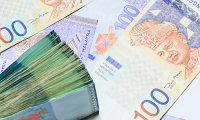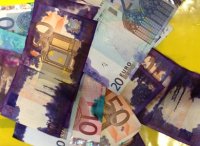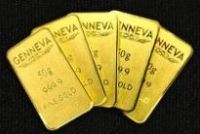 Bank Negara Malaysia (BNM) was established on 26 January 1959 and it is the sole issuer of Malaysian Ringgit. On 12 June 1967, the first Malaysian Ringgit issued to replace the Malaya and British Borneo dollar.
Bank Negara Malaysia (BNM) was established on 26 January 1959 and it is the sole issuer of Malaysian Ringgit. On 12 June 1967, the first Malaysian Ringgit issued to replace the Malaya and British Borneo dollar.
In 1993, the currency symbol “RM” (Ringgit Malaysia) was introduced to replace the use of the dollar sign “$”.
Since the first issuance, the value of gradually increase as Malaysian economy prospers. Do you know how much is printed Malaysian Ringgit Currency Note in circulation?
The table below show the total the of Malaysian Ringgit Note circulated in the economy since 1975 excluding RM500, RM1,000 notes and coins valued about RM2 billion.
[continue reading…]
 This article is an adaptation from a section of Sharif Rahman’s latest book which concluded his detailed explanation on gold’s multitude of failures. His latest book is titled, “Kegagalan Emas Sebagai Matawang” and is sure an exciting read because he also took the time to explain the justice of “interest”.
This article is an adaptation from a section of Sharif Rahman’s latest book which concluded his detailed explanation on gold’s multitude of failures. His latest book is titled, “Kegagalan Emas Sebagai Matawang” and is sure an exciting read because he also took the time to explain the justice of “interest”.
Ever wonder why the money in your hand is considered valuable, even if the paper it’s printed on is just that, mere pieces of beautiful paper? Many gold bugs made the silly accusation that these pieces of paper have no value and are no match when compared to their shiny gold bars and coins. They claimed that the Ringgit’s value is simply being dictated by the government and the government is forcing the people to accept it. Thus the typical word they used to badmouth the currency is “fiat”. Fiat means decree, and a long time ago, that was the case. However today, our paper money is no longer a mere fiat currency, it is a currency that is soundly backed, and the backing is far superior to using gold as the support.
[continue reading…]
 Malaysians have the conviction that Singaporeans are doing far better than Malaysians do. In many specialized areas, indeed, the level of superiority of Singapore seems to be light years away compared to Malaysia. However when all things are smoothened out, and the data is generalized over the entire country (Malaysia is much bigger and populous than its neighbor, by as much as 1,400 times and 6 times respectively), we can see that the overly emphasized achievements of Singapore (or the lack of achievements on the part of Malaysia) will fall apart.
Malaysians have the conviction that Singaporeans are doing far better than Malaysians do. In many specialized areas, indeed, the level of superiority of Singapore seems to be light years away compared to Malaysia. However when all things are smoothened out, and the data is generalized over the entire country (Malaysia is much bigger and populous than its neighbor, by as much as 1,400 times and 6 times respectively), we can see that the overly emphasized achievements of Singapore (or the lack of achievements on the part of Malaysia) will fall apart.
The most overarching example is the comparison of the exchange rate between the two countries.
[continue reading…]
 If someone or shop pass to you Dye-Stained Banknotes banknotes don’t accept it. Beware, the banknotes may come from banks or ATM machine’s robbery! We obviously don’t want to be implicated in any on these criminals.
If someone or shop pass to you Dye-Stained Banknotes banknotes don’t accept it. Beware, the banknotes may come from banks or ATM machine’s robbery! We obviously don’t want to be implicated in any on these criminals.
Recently, due to sharp increase in ATM robberies in Malaysia, Bank Negara Malaysia (BNM) introduced Currency Protection Device (CPD) to deter ATM robberies.
CPD will emit a bright-colored dye ink (using either smoke and/or liquid dye or any other agent) to stain banknotes in the event the ATMs/CDMs are attacked.
[continue reading…]
 On the 1st of October 2012, Genneva Gold raided by both the authorities in Malaysia and Singapore for suspected offences including illegal deposit taking, money laundering, tax evasion and avoidance, false description (misrepresentations), appointment of agents without licence, and failing to lodge statutory documents.
On the 1st of October 2012, Genneva Gold raided by both the authorities in Malaysia and Singapore for suspected offences including illegal deposit taking, money laundering, tax evasion and avoidance, false description (misrepresentations), appointment of agents without licence, and failing to lodge statutory documents.
Soon after, there are a lot of comments and denial by Genneva Gold customers & consultants (agents), and they start to blame the authorities. They are even set up Genneva Support Group on Facebook. In the group, there was a comment made by Richard Chew who clearly explained the scam and the flaw on Genneva business. Unfortunately, the comment was deleted within a few minutes.
I like to share his comment so that everyone understands the reason why Genneve Gold is indeed a scam. Read on his comments below,
[continue reading…]
 Bank Negara Malaysia (BNM) was established on 26 January 1959 and it is the sole issuer of Malaysian Ringgit. On 12 June 1967, the first Malaysian Ringgit issued to replace the Malaya and British Borneo dollar.
Bank Negara Malaysia (BNM) was established on 26 January 1959 and it is the sole issuer of Malaysian Ringgit. On 12 June 1967, the first Malaysian Ringgit issued to replace the Malaya and British Borneo dollar.
 Malaysians have the conviction that Singaporeans are doing far better than Malaysians do. In many specialized areas, indeed, the level of superiority of Singapore seems to be light years away compared to Malaysia. However when all things are smoothened out, and the data is generalized over the entire country (Malaysia is much bigger and populous than its neighbor, by as much as 1,400 times and 6 times respectively), we can see that the overly emphasized achievements of Singapore (or the lack of achievements on the part of Malaysia) will fall apart.
Malaysians have the conviction that Singaporeans are doing far better than Malaysians do. In many specialized areas, indeed, the level of superiority of Singapore seems to be light years away compared to Malaysia. However when all things are smoothened out, and the data is generalized over the entire country (Malaysia is much bigger and populous than its neighbor, by as much as 1,400 times and 6 times respectively), we can see that the overly emphasized achievements of Singapore (or the lack of achievements on the part of Malaysia) will fall apart. If someone or shop pass to you Dye-Stained Banknotes banknotes don’t accept it. Beware, the banknotes may come from banks or ATM machine’s robbery! We obviously don’t want to be implicated in any on these criminals.
If someone or shop pass to you Dye-Stained Banknotes banknotes don’t accept it. Beware, the banknotes may come from banks or ATM machine’s robbery! We obviously don’t want to be implicated in any on these criminals. On the 1st of October 2012, Genneva Gold raided by both the authorities in Malaysia and Singapore for suspected offences including illegal deposit taking, money laundering, tax evasion and avoidance, false description (misrepresentations), appointment of agents without licence, and failing to lodge statutory documents.
On the 1st of October 2012, Genneva Gold raided by both the authorities in Malaysia and Singapore for suspected offences including illegal deposit taking, money laundering, tax evasion and avoidance, false description (misrepresentations), appointment of agents without licence, and failing to lodge statutory documents.